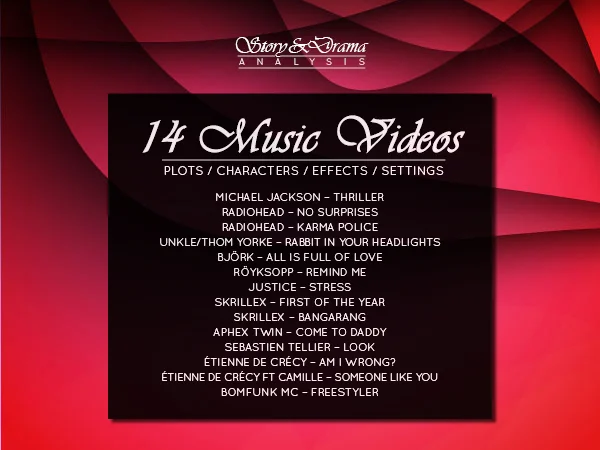 |
|
PDF, 133 pages
|
| Read the scenario analysis of 14 music videos |
Michael Jackson’s Thriller was released in 1983 in the UK and 1984 in the US by Epic Records, from Michael’s 6th studio album Thriller.
Written by Rod Temperton and produced by Quincy Jones, the song was made into a music video directed by John Landis, as a kind of horror movie, in which Michael transforms into a werewolf then performs a dance routine in the middle of zombies. The song and the music video strongly impacted american pop culture.
This music video analysis of the song Thriller by Michael Jackson is an abstract from our tutorial e-book 14 music videos. It uses some terms and vocabulary specific to storytelling.
Music video
- Music video director: John Landis
Analysis of Thriller
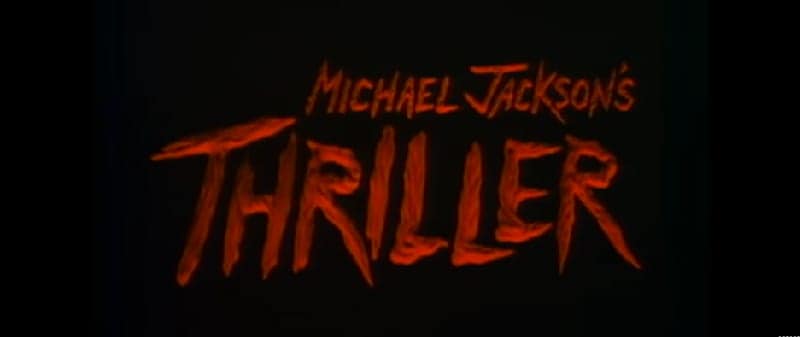
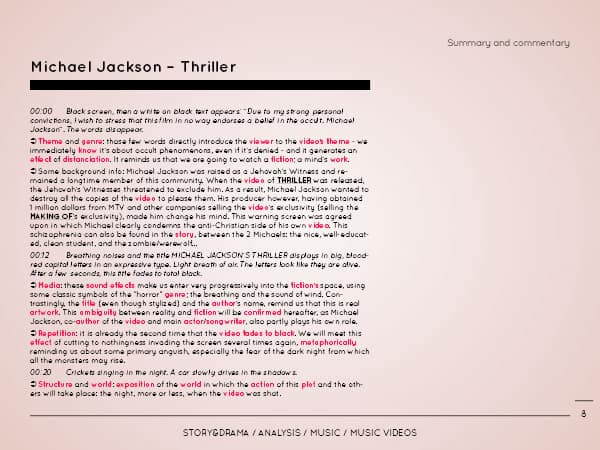 |
Picture above : a page of our Music video analysis.
Intro
00:00 Black screen, then a white on black text appears: “Due to my strong personal convictions, I wish to stress that this film in no way endorses a belief in the occult. Michael Jackson”. The words disappear.
Theme and genre: those few words directly introduce the viewer to the video’s theme – we immediately know it’s about occult phenomenons, even if it’s denied – and it generates an effect of distanciation. It reminds us that we are going to watch a fiction; a mind’s work.
Some background info: Michael Jackson was raised as a Jehovah’s Witness and remained a longtime member of this community. When the video of Thriller was released, the Jehovah’s Witnesses threatened to exclude him. As a result, Michael Jackson wanted to destroy all the copies of the video to please them. His producer however, having obtained 1 million dollars from MTV and other companies selling the video’s exclusivity (selling the Making Of’s exclusivity), made him change his mind. This warning screen was agreed upon in which Michael clearly condemns the anti-Christian side of his own video. This schizophrenia can also be found in the story, between the 2 Michaels: the nice, well-educated, clean student, and the zombie/werewolf…
00:12 Breathing noises and the title MICHAEL JACKSON’S THRILLER displays in big, blood-red capital letters in an expressive type. Light breath of air. The letters look like they are alive. After a few seconds, this title fades to total black.
Media: these sound effects make us enter very progressively into the fiction’s space, using some classic symbols of the “horror” genre; the breathing and the sound of wind. Contrastingly, the title (even though stylized) and the author’s name, remind us that this is real artwork. This ambiguity between reality and fiction will be confirmed hereafter, as Michael Jackson, co-author of the video and main actor/songwriter, also partly plays his own role.
Repetition: it is already the second time that the video fades to black. We will meet this effect of cutting to nothingness invading the screen several times again, metaphorically reminding us about some primary anguish, especially the fear of the dark night from which all the monsters may rise.
A lovers walk in the forest at night
00:20 Crickets singing in the night. A car slowly drives in the shadows.
Structure and world: exposition of the world in which the action of this plot and the others will take place: the night, more or less, when the video was shot.
00:35 The car’s engine produces an abnormal sound. The car stops on the way. The headlights turn off.
Structure: this engine failure appears to be the catalyst of a first plot, number 1.
00:46 Michael Jackson is in the driver’s seat, dressed as a standard American student. A young woman is sitting next to him. She watches him with questioning eyes. He explains, laughing, that they ran out of gas. She asks: “So what are we going to do now?”
Characters: Michael and the young woman are the Heroes of this plot 1. Their Antagonist is the fact that they ran out of gas in a deserted place and their goal will be to get out safely from this potentially dangerous situation (which does not seem very difficult at the moment since they can walk, a car could take them away, etc…)
Some background info: The actress (Ola Ray) who plays Michael’s girlfriend was spotted after she posed naked in the centre pages of American Playboy. We can guess the Christians and especially the Jehovah’s Witnesses appreciated that too…
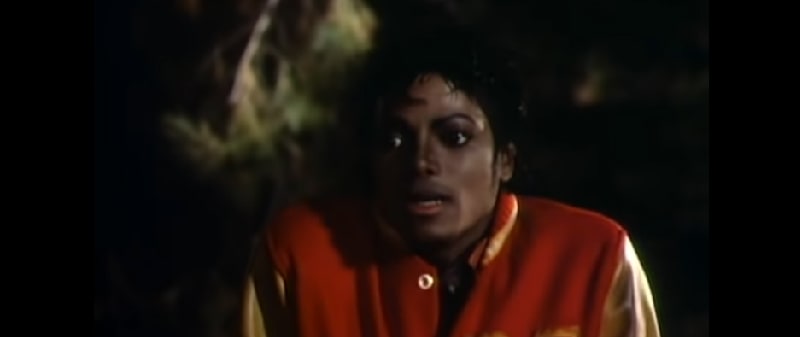
01:00 They walk side by side silently. After a few moments, he asks her to be his girl and she is overjoyed. He then offers her a ring which she accepts with delight. He then has a kind of remorse however and announces solemnly that he is… “different” to other guys.
Structure: this scene discloses a second plot, number 2. Michael’s goal as the Hero consists in winning over this young woman to make her his girlfriend. As he realizes his goal almost instantly, without antagonism, opposition nor conflict, we could believe that the plot already ends there (unless it were to get more complex).
02:10 A melody starts playing, a shot of the moon unveiling behind the clouds. Michael starts having a kind of convulsive episode. She observes him, worried, obviously trying to understand what is happening. “Are you OK??” she asks him, while he is bent in two, seemingly in pain.
Structure: this scene changes the data of the idyllic love plot 2, standing as its true catalyst.
02:24 He sits slightly back and his face has totally changed: he now has carnivorous teeth, a darker skin, horrible yellow eyes, and he shouts to her “Go away!”with a beastly voice. She screams, horrified. Michael’s metamorphosis continues as he screams again, his bones cracking, his jaws widening, whiskers developing, his teeth growing, as well as his hair, ears, and nails. He has become a horrible werewolf wearing the clothes of a nice standard American student. She screams and runs away.
Structure: with this confirmation of the catalyst, the love plot 2 turns into a horror plot – number 3, radically modifying the actantial roles of the characters, their goals and their issues. Michael becomes the Hero against his girlfriend (who becomes his Antagonist), whose goal is to save her life against her monstrous boyfriend.
03:02 She runs wildly in the forest, the werewolf running after her. He destroys a tree while passing by and screams at her.
03:36 He suddenly rises up in front of her and she falls on the ground, unable to protect herself, scared. He roars, threatening her and she screams.
Structure: we just witnessed the development of Act II (very logical) of this horror plot 3 and we now come to the crisis of Act III: direct meeting between the Hero and his Antagonist.
03:43 In a perfect soundtrack continuity, we suddenly see the many viewers of a cinema room, following the action on-screen. Michael is sitting in the middle of the crowd and is looking like he’s having fun, while his girlfriend, on the contrary, is looking scared.
The screaming continues. We can assume that the werewolf of the film goes on attacking the poor scared girlfriend, while Michael is happily eating up his popcorn. A male voice in the film soundtrack says: “He’s over here!”, another one says: “Oh my god, look at that thing!”, then shooting breaks out.
The girlfriend of Michael in the cinema room asks him: “Can we leave?” . Michael replies: “Nooo, I’m enjoying it!” She says she can’t watch the movie any more, gets up and leaves.
Michael takes a look at the screen, hesitates a moment, gives his popcorn to his neighbour, gets up and starts following his girlfriend. He is dressed in a red leather suit.
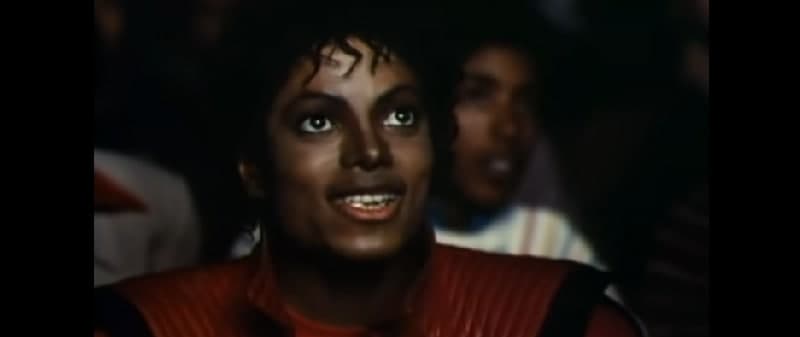
Media: the soundtrack’s continuity helped make us understand that the plots 1, 2 and 3 which we were following were the ones of a movie, from a fiction.
Special effect: here we have a case of a film in the film, a fiction in the fiction, a spectacular mise en abyme.
Structure: all at once, everything we saw from the very beginning appears to actually be a false track, making the exposition (Michael and his girlfriend at the cinema) and the catalyst (the girlfriend leaving the room) of a plot number 4, whose Hero is Michael, enjoying the horror story and wanting to stay against the will of his Antagonist (the girlfriend who is scared and prefers to leave).
This plot 4 has the same theme as the previous one: a love story, a couple.
The movie theater
04:14 A wide and bright light display shows: “Palace / Vincent Price / Thriller”. The music of Thriller starts. The camera moves to show an uplifting view of the hall of the cinema. The girlfriend is walking out of it and Michael follows her outside.
Pattern repetition: it is the second time the title of the video, and of the famous soundtrack, integrates the fiction.
Michael says: It’s only a movie.
This line underlines the mise en abyme with a strong dramatic irony. Actually we, the audience, are in the same situation as Michael’s girlfriend: we have to follow the action without leading it, we watch and we feel a bit scared, at least from having been easily manipulated.
Girlfriend: – It’s not funny.
– You were scared, weren’t you?
– I wasn’t that scared…
– (Laughing) You were scared.04:40 They walk in the dark night. While she walks, he starts singing and dancing around her. She starts dancing with him, comforted and happy again.
Structure: we enter Act II of plot 4, even if – for the moment – the source of the conflict (the terror coming from the fiction movie) seems to have totally disappeared. The dramatic tension, after a first rise, has now fallen back to zero.
Now come the lyrics of the song Thriller (find them online if you like), full of gloomy evocations and horrific allusions.
These lyrics directly adress a “you” who is hard to identify: it could be Michael’s girlfriend, or the video’s viewer, or any other human being able to listen to the song. The use of the “you” makes it easier for the viewer to identify with the story and it flatters us, because the star – the main character of the video and of the song – seems to be addressing us directly.
Structure: these scenes of singing and dancing complete the data of plot 4. We understand that in the frame of their love story, the goal of the Hero Michael consists of familiarizing his girlfriend with the feelings of fear and horror so that she accepts being able to play with them.
06:25 They come to a cemetery. Around them are many tombs.
In the song, a deep male voice mentions the mid-night hour when the creatures from Hell come and disturb the world of the living people.
Structure: we do not know it yet, but this part, included in plot 4’s Act II, can also stand as the exposition (Act I) of plot 5 to come…
In the meantime, we zoom-in on a tomb. The smoky ground moves, a tombstone slides open, bodies come out from the ground and little by little, dozens of zombies emerge with a dazed look, green torn skin and tattered clothes.
07:33 The voice describes zombies and the music gets more intense.
Structure: with the zombies emerging (who are going to become the Antagonists of Michael and his girlfriend), Act II finally takes on a truly strong, dramatic dimension, since the viewer has known that Michael’s song was meant to describe terror without truly provoking it. Zombies call to the old unconscious background of imagination described by Campbell and Vogler.
Again, the dramatic tension suddenly peaks, imitating perfectly the emotion of terror – a sudden shot of adrenalin.
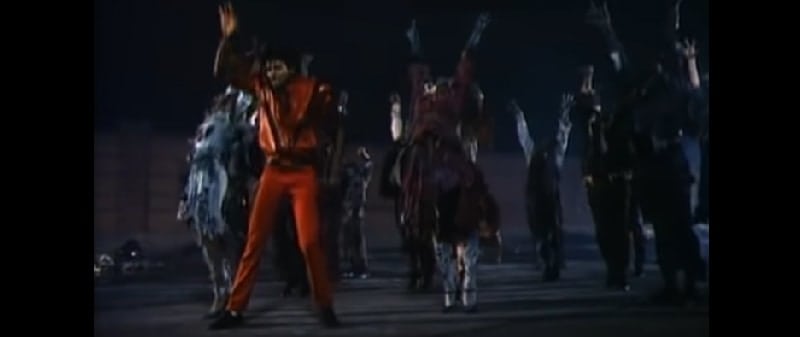
08:04 The zombies are gathered in a group on the street and Michael and his girlfriend, who were arriving from the other way, freeze. The zombies circle them. The music stops and leaves only room for silence. The couple faces danger, hopelessly wanting to get out of the circle of zombies.
Structure: new important modification of the dramatic data and the characters’ table. Michael and his girlfriend become the Heroes of a plot number 5 through self-defense against the zombies (Antagonists), a plot which will end here because it only was another false track, or rather a temporary version. At the same time, this scene forms the beginning of a sort of long crisis of plot 4 about Michael playing with the fear of his girlfriend.
08:26 Suddenly, Michael has been transformed; bulging eyes, frightening face. His girlfriend watches him, terrified. He starts dancing in a jerky way, accompanied by the troop of zombies.
Structure: the crisis goes on with another major change in the dramatic data, thus opening up a new plot, number 6, since Michael – previously the Hero – becomes the Antagonist (his goal: to kill his girlfriend, unlike being the Hero whose goal is to save her life, as in plot 3). This change redefines the zombies as Michael’s Helpers.
Simultaneously, the pattern repetition of his transformation into a beastly and scary supernatural creature troubles the mind of the viewer, tempted to see in this scene a continuation of plot 3, told in the cinema movie.
09:40 Michael starts singing the chorus “‘Cause this is thriller”, which ambiguously mixes a will to scare and a will to comfort.
Themes and characters: this thematic ambiguity of the song adds up to the deep ambiguity about Michael’s real actantial role – Hero or Antagonist? Wild beast or civilized savior?
The abandoned house
10:35 The girlfriend is running away into the night. She enters an abandoned house. The zombies follow her. The music stops and footsteps, grunts, and other strange noises invade the soundtrack.
Structure: the Act II of plot 6 develops with this new turn of events.
11:07 In the darkness of the empty house, the girlfriend is looking for a way out. The zombies break the windows, emerge from the wooden floors, the girlfriend flops onto a bed and screams in terror. Michael and the zombies get closer and closer to her and she screams.
Structure: plot 6 enters into its crisis (Act III) – the dramatic tension reaches its peak. The viewer feels that the dramatic answer and the climax are soon to be revealed.
11:47 The scenery suddenly changes: an apartment, in the evening. Michael is standing in front of his girlfriend, dressed in his red leather suit and with a normal, smiling face he asks her casually: “What’s the problem?”. He embraces her, she smiles, comforted. He starts leading her out through the living-room to take her home.
Structure: climax! Plot 6 gets resolved in a totally unexpected way by cancelling itself, as the previous scary cinema movie plot cancelled itself. The scene could also stand as the exposition of a plot number 7, in which the Hero Michael would have to rescue his girlfriend from her worst nightmares, as a goal…
11:58 He turns back to us (or the camera), smiling widely and staring at us with his yellow werewolf eyes, while a fiendish laughter bursts out and the picture freezes. The camera slowly zooms-in on this last picture and the music of Thriller starts again.
Characters: this final twist confirms the double nature and the deep ambivalence of the character of Michael (and probably of Michael Jackson himself, who wrote that crazy ambivalent story); charming seducer and scary monster…
Structure: it is questionable whether plot 6 will truly end here, or whether Michael will turn into a beast again and scare his girlfriend.
12:05 The final credits appear: “Directed by John Landis, Written by John Landis and Michael Jackson”, etc…
Structure: this meta-narrative element which comes to close the fiction, completes the opening in a very symmetric way, creating the nice impression that we are back to normality (and to reality) after the crossing of a chaotic story.
12:22 The dance with the zombies starts again.
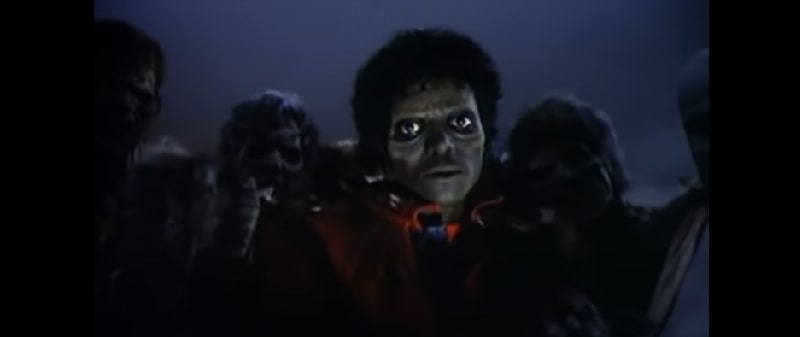
Structure: this new start of the song and of the dance show, like a bonus, makes the previous element appear as a wrong track, a false end. At the same time, since the previous plots 4, 5 and 6 were resolved, in an unexpected but rather satisfying way, we do not really expect the action to start again.
Outro
13:17 A headless zombie slowly walks in the darkness. A message displays: “All the characters of this film are fictitious. Any similarity with some events or people, living, dead (or undead) would be purely coincidental.” Two other zombies join the first one and they dance together.
Structure: as before, this message is perfectly symmetrical to the initial message in which Michael warned the viewer that he did not believe in the occult. Those messages, juxtaposed with the march of the beheaded zombie, stay in the logic of deep ambivalence to the plots of the video.
13:40 On a last repetition of Thriller’s main music theme, coming from the song’s chorus, an awful grinning and smiling face, with bushy hair and rotten flesh, is watching us.
Structure: same paradox as before: we have just been told not to believe in the occult and yet we are observing this living dead…
13:42 Black screen.
Structure: this last effect of symmetry (in the very beginning, the video faded in from black screen to the picture) reinforces again the structure of parallelisms, giving the overall video an air of perfection, of mastership of logics, of rationality. Whereas the video is made from all the contrary: inexplicable breaks of the plots, illogical absurdities, irrationnal terrors, uncontrollable daydreams, and deep ambiguities…
Comment – Thriller’s story structure and meaning

Plots: a story within the story within the story
In a very original way, the plot of Thriller makes for high-quality dramatic effects:
- a double mise en abyme
- a remarkable effect of information distribution asymmetry
- an effect of an anti-chronological montage
Let’s detail those three technical points.
A mise en abyme is the representation or inclusion of a work within another work, one repeating the other on an inferior or superior scale.
For example, a picture within a picture, a book within a book, or like here a film within a film. It is a form of fractal or recursive pattern.
If we sum up the video after having seen it, we can state that the story actually tells this:
- A woman is dreaming (she abruptly wakes up at 11:47) that she got lost in a forest (from 04:40) with her boyfriend who has turned into a werewolf (since 08:26)…
- … after they saw a horror movie at the cinema… (this lasts from 00:20 but we clearly know it only from 03:43)…
- … movie which showed them lost in a forest (from 00:20) and in which he turned into a werewolf (from 02:24)…
We thus have a love movie rather than a horror movie (which Michael and his girlfriend watch at the cinema) that is part of a dream (created by Michael’s girlfriend) which is part of a love and horror movie (Thriller’s video itself).
As we can see, the facts are told in an order which reverts the chronological order, that is why we use the term “anti-chronological montage“ (anti = contrary).
This structure gets very progressively revealed, which is why we speak of an information distribution asymmetry:
- When us viewers watch the first plot (the one with the “out of gas” situation of the couple in the forest), we ignore it as a scene in a film, whereas the characters of Michael and his girlfriend know well that they are at the cinema watching a film named… Thriller.
- And when us viewers watch the plot in which Michael and his girlfriend have a walk together in the night after having left the cinema and later attacked by the zombies ruled by their boss Michael, we ignore that it’s in a nightmare of Michael’s girlfriend. Whereas she, once awoke or even before, knows it, as Michael also knows, that he was not really involved in his girlfriend’s dream…
To make things even more complex, the video disrupts our mind at the end by a last enigma: if the first transformation of Michael into a werewolf was a false track, since it happened in a film, and if the second transformation of Michael into the leader of the zombies was also a false track, since it happened during a nightmare, then, why does Michael finally have the same yellow eyes he had in the film as well as in the nightmare? This question may never be solved, but simply sketched a last time when the video ends with the signatures of the scriptwriters Michael Jackson and John Landis, who claim the video as a work of pure fiction: this way, even the last Michael is a fiction, so that there is no mystery. But still… a doubt remains.
Imagine now that we would tell the exact same story in a chronological order:
- a young woman is dreaming,
- in the nightmare she goes to the cinema with her boyfriend,
and they see themselves in a film running out of gas in the forest etc…, - they leave the cinema then walk together in a forest and are attacked by zombies,
- and finally her true boyfriend wakes her from her nightmare.
Such a story, with exactly the same narrative data, the same characters having the same actantial roles and the same goals, would not have had the same impact at all. The dramatic tension would be much weaker and the meaning of it all would radically change.
As we exposed it in Storytelling 1 and Storytelling 2, a story is not only a bunch of facts, of actions, of characters, but also a narrator (here omniscient) who tells us these events in a given order, and thus builds a story involving not only setting up the basic data of the plots, but also telling them in the right, strong or relevant order.
You will find on the next page a summary of the plots (and of the actantial roles of the characters) which will lead us to the question of the telling.
The plots and the actantial roles
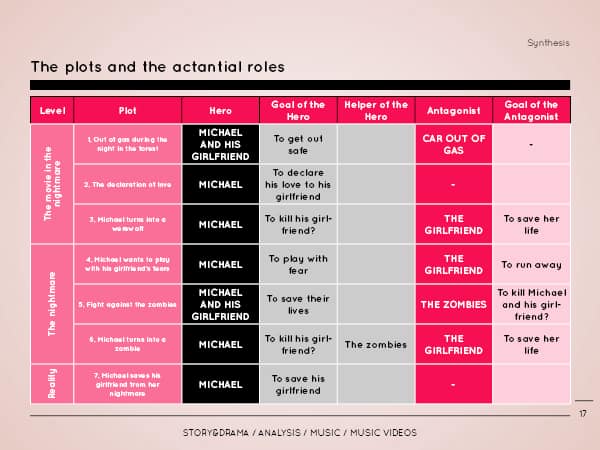 |
|
PDF, 133 pages
|
The telling
The telling explains most of the quality of the video Thriller.
This telling uses several types of plot structures (see them in Storytelling 2):
Factorial plots
A plot is factorial when it is a part of another plot. This rather rare technique is by far the majority structure in Thriller, almost to delirium: nearly each plot is part of another one and stands as its exposition.
Thus, plot 1, couple ran out of gas in the dark forest, exposes plot 2, declaration of love, which exposes plot 3, transformation into werewolf, which exposes plot 4, in which Michael and his girlfriend watch a film, which exposes plot 5, in which Michael and his girlfriend are attacked by zombies, which exposes plot 6, in which Michael has become the boss of the zombies, which exposes plot 7, in which Michael gets his girlfriend out of her nightmare, by going out of a box into a box into a box…
Plots in series
Simultaneously, the same plots also work in series, that is to say they take exactly the same characters and give them different actantial roles and goals.
For instance, plots 1, 2, 4, 5 and 7 give Michael a good role of nice, slightly cruel but correct boyfriend, loving his girlfriend and caring for her, whereas both plots 3 and 6 give Michael a role of monstruous Hero, a threat to his girlfriend in position of Antagonist, as if the same story was repeated on two different scales.
As in fantasy tales, these repetitions of structure mimick a well-known type of madness: obsession.
…
Did you enjoy reading an extract from this music video analysis? Do you want to read more?
Do you want to learn to write a music video script?
Then read our e-book: scenario analysis of 14 music videos.